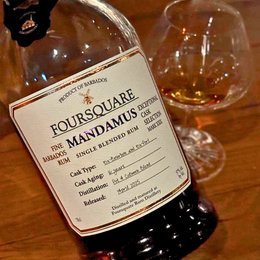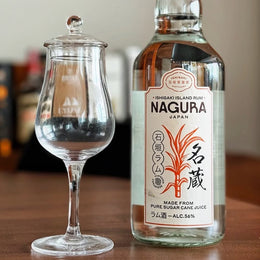Hampdens, pushing 1000: Old Brothers Jamaican Rum 2001 (19 years) & Rum Sponge Edition No. 6, JMH Jamaican Rum (29 years)

Background: two rums with ester concentrations not far from 1000g/hlpa. One is a tropically aged cask of mark <>H. The other is a blend of two marks, HLCF and C<>H. The three vintages involved are very well regarded, so let’s see how the end products stack up against the competition.
Name: Old Brothers <H> Jamaican Rum 2001 (19 years)
Nose: big wood support; a tightly woven core of aromas, threading overripe jackfruit and pineapple and banana with tar, wet earthenware, burnt plastic, cooking gas, and baskets full of salmiak liquorice and dark chocolate; the top notes are acidic, sometimes acridly so; red yeast rice wine and its by-products -- think Shaoxing jiu and hong zao; balsamic vinegar; oxidised and rotting apples; grape bubblegum; rotting and preserved plums and citrus peels; deeper in the glass, there are meats and miscellaneous fermented edibles; smoked ribs; honey baked ham; pork floss; a cross between bak kwa and Kuala-Lumpur-style char siew; sweet and sour pork, topped with generous servings of Marmite and stir-fried lychees; cheese rind; fermented bean pastes running the gamut from fu ru to dou ban jiang; ika shiokara; a blend of satay sauce and McDonald’s curry sauce; the base notes include sweet, syrupy dou hua, thick, creamy sandalwood, paddy field, compost, and general waste in a rubbish bin.
Palate: thick and rich as hell; the wooden heft and the core of the nose are both replicated here; haw flakes; red yeast rice wine concentrate; berry compote on yoghurt; a bunch of sweet-savoury sauces -- say, barbecue sauce and plum sauce and shacha sauce and Thai fish sauce; sharp blue cheeses and old hard cheeses; some fried starch, like a butterfly bun or a burnt french toast; walnut and almond paste; fresh cuttings and fresh grass; that fruity hard candy note in the best strong aroma baijius, with strawberry, pineapple and watermelon taking the centrestage; pineapple and mango cordial; the back-palate is smoky and savoury; smoked ham; aburi shime saba; a cornucopia of Cantonese roast meats, specifically char siew and roast duck, with a sprinkle of lard cracklings.

Finish: long; more starch, this time towards fried plantain and tapioca cake and roasted sweet potato; overripe strawberry and tropical fruits and cream accompany a redux of the “red” front-palate – red fruits, red yeast rice, “reddish” sauces; wet wood; forest floor; musty cardboard; grilled mushrooms seasoned with cumin; McDonald’s curry sauce comes back in the aftertaste, along with sesame oil, peanut skin, liquorice, more fruity hard candies, mocha latte, chocolate pralines and vanilla.
Conclusion: a cousin to the Habitation Velier C<>H. Same chewable mouthfeel, more Chinese liquor homages (to both huangjius and baijius), more fermentation notes, less brine and less earthiness. There, close enough. In all seriousness, 18 years of tropical ageing did wonders in imparting weight and curious flavours to this rum. There is an air of fermented brightness and fruitiness enveloping the liquid, and less in the way of industrial and inorganic notes so often dominant in high-ester Hampdens. Another very special Hampden from 2001 (after that Thompson Brothers bottling), and a really great one at that.
Score (assuming a normal distribution with mean 50): 93/100
Name: Rum Sponge Edition No. 6, JMH Jamaican Rum (29 years)
Nose: fluid, expressive and very accessible; more acetone-forward than the Old Brothers, but also more perfumey; floral incenses and essential oils, of myrrh and frankincense in particular; gasoline; the green notes of a rainforest, with all its vines and leaves; a young malt whisky, like the three-year-old Shizuoka I tasted recently, with notes of barley, maltose, citrus fruits, apple juice and stewed apple (is that why they say Rum Sponge picks rums for whisky drinkers?); a bunch of salty, savoury aromas; salted lassi; honey baked ham; sushi rice dipped in soy sauce; on the whole, it is still much less savoury than the Old Brothers; the malt and rice combination reminds me of the 1986 batch of “Rockley still” rums; yellow fruits and tropical fruits, the less pungent ones – pineapple, mango, passion fruit, banana, soursop; mixed nuts paste and campfire smoke are the stars among the base aromas.
Palate: pretty good mouthfeel, not thin by any means, just pales in comparison to the Old Brothers; flavour-wise, it follows the nose almost to a tee, so I shall only note the differences; the maltiness on the nose does not translate to the palate, but the citrus and apple notes do; in addition, there are cooking herbs and spices – I detect parsley, rosemary, scallion and sansho – as well as mentholated herbal ointments, resinous camphor, olive brine, and saline coastal peat a la Talisker; the nuttiness is also more pronounced here than on the nose – almond and peanut paste constitutes the backbone of the palate.
Finish: very long; more gasoline and ointments; earthy and grassy forest floor notes; finally some fermented funk shows up, in the forms of sweaty socks and first morning urine; nuts and anise; then a barrage of fruits; tropical fruit punch; stone fruits, specifically canned peach and dried apricot; apple pie; frozen yoghurt with a side of fried doughnut; the aftertaste is big on earth, smoke, iodine, plastic and brine, with hints of tropical fruit candy and white lotus seed paste.
Conclusion: colour me impressed. As far as I am concerned, the Rum Sponge editions before this are rather disappointing. When I first caught wind of them “smooshing” HLCF juice with a cask of the legendary 1990 vintage, I could not shake the feeling that they are going to whisky-fy this, as usual. Imagine the sigh of relief I let out upon the first nose. Yes, this is still huge, high-ester Hampden, alright. The depth of wood and uncompromising smoke indicative of the best 1990 Hampdens are there, mellowed but not muted. Tropical fruit candy and cordial notes so typical of HLCF, feel right at home amidst the various facets of beastly funk C<>H has proven capable of. Would I have preferred the 1990 on its own? Very likely so. But how much can I fault Angus for attenuating the learning curve of glorious, glorious Hampden appreciation?
Score (assuming a normal distribution with mean 50): 90/100
Image Courtesy of u/zoorado.
![]()
u/zoorado







